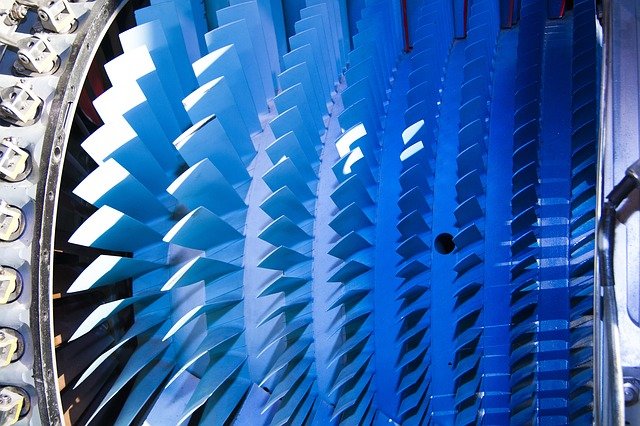How does a turbine engine work? Do you want to know? Then let me provide you with some interesting facts today. A turbo jet engine is a simple turbine engine. It functions by increasing the air pressure and temperature. As a result, this creates a high velocity that makes the jet engine move forward.
This article will explain the technology behind the jet engine in a logical step-By-step Manner. The things that you will learn from this article:
- How does a Turbine Engine Work?
- Newton’s Third Law of Motion
- How to create very hot and high-speed air to escape through the engine? How does this help in the jet engine?
- Combustion Chamber
- Compressor Stages
- Turbine
- 2 Spool Arrangement
- Turbo Jet Engine
- Turbo Fan Engine
- How to keep the noise of the jet engine to a minimum?
How does a Turbine Engine Work?
Jet engines have been the successful drivers of aircraft for nearly a century now. A jet engine keeps an aircraft moving forward using a very simple principle.
Newton’s Third Law of Motion
“To Every Action, there is an Equal and Opposite Reaction.”

Now, you might be thinking about how this law is applicable for jet engines. This law is the most prominent principle for jet engines. There is a production of a reaction force by the high-speed jet at the tail of the jet. This makes the engine move forward.
Let us learn using Analogy.
You must have got a chance to see balloons fly up when air leaks from the bottom. Air-filled balloons move upwards due to high-velocity downward force by the inner air. This produces an upward reaction force. This takes the balloon upwards. This is the basis of Newton’s Third Law.
You can view a similar mechanism in jet engines.
How to create a very Hot and High-Speed Air to Escape through the Engine? How does this help in the Jet Engine?
The working of a jet engine is all about producing a High-speed jet at the exit.
Why we need to heat the incoming air:
- The higher the speed of the jet the greater the thrust force.
- The thrust force makes an aircraft move forward.
- There are many techniques to achieve such high-speed exhaust.
- If you can heat the incoming air to a high temperature it will expand tremendously and will create a high velocity.
Combustion Chamber
Now, in order to expand the air to a higher temperature, a combustion chamber comes in handy:
- An atomized form of the fuel is burnt in the combustion chamber.
- Effective combustion requires air to be at moderately high temperatures and pressure.
Compressor Stages
To bring the air to a higher temperature and pressure a set of compressor stages become very useful:
- The rotating blades of the compressor add energy to the fluid.
- Its temperature and pressure rise to a level suitable to sustain combustion.
Turbine

The compressor receives the energy for the rotation from a turbine.
How a turbine helps:
- This turbine stays right after the combustion chamber.
- The attachment of the compressor and turbine are to the same shaft.
- The High-energy fluid that leaves the chamber makes the turbine blades turn.
- The turbine blades have a special airfoil shape.
- It creates lift force and makes them turn.
- As the turbine absorbs energy from the fluid its pressure drops.
The turbine has two parts:
- Rotor Blade
- Stator Blade
Here, the temperature rises from 10°C to 450°C and the pressure reaches 3500 kilopascals from 75 kilopascals. Through these steps, we can say why it is important to heat the air in a jet engine.
The engine case becomes narrower towards the outlet. As a result, there is a creation of an even greater jet velocity. In short the combination of the compressor, combustion chamber and turbine makes the aircraft move forward.
2 Spool Arrangement
Modern aircraft use a slightly different compressor turbine arrangement which we know as a two-spool arrangement.

How it works:
- There are two independent turbine compressor stages here.
- The shaft of the outer compressor turbine passes in-between through the inner one.
- The outer turbine comes in contact with a low-energy fluid.
- The outer turbine runs at a slower speed than the inner turbine.
- Low-pressure blades become longer.
- This low speed helps to reduce centrifugal stress at the root.
This improves the blade’s life.
There are 2 parts involved in this arrangement:
- Outer Compressor
- Outer Turbine
Some modern aircraft even use a three-spool engine.
Turbo Jet Engine
Turbo jet engines are typical air-breathing jet engines. Its use is mostly in aircraft. The engine we so far came to know today is more specifically a turbo jet engine. A disadvantage of it is that it tends to produce high levels of noise.
Turbo Fan Engine

A Revolutionary Improvement to this engine is the placement of a large fan with the low-pressure spool. These engines are what we know as Turbo fan engines. Almost every commercial aircraft runs using them. A Turbo fan engine bypass is a huge amount of air. The narrow bypass duct provides a good jet velocity to the passing air in a turbo fan engine.
How the Fan helps in the process:
- The majority of the thrust force comes from the fan’s reaction force. So, here also you can see the application of Newton’s third law of motion.
- Furthermore, the fan greatly improves Airflow in the system by sucking in more air.
- Thus it helps to improve the thrust. This means the creation of high thrust with an expense of slightly less fuel.
- This is the reason why Turbo fan engines highly fuel economical.
The Turbo Fan Engine also has two parts:
- Rotor Blade
- Stator Blade
How to keep the Noise of the Jet Engine to a Minimum?
The noise produced by a jet engine depends highly on the exit jet velocity. In a turbofan, the passing cold air mixes with the hot air. So, it is possible to keep the outlet velocity within a limit.
Thus it overcomes the noise problem.
The Turbo Fan Engines dominate the aircraft propulsion systems.
Merits:
- Quieter exhaust
- Better fuel economy
Conclusion
I hope you enjoyed my ultimate guide to how does a turbine engine work.
Now I’d like to hear from you: which technique from today’s guide did you like? Are you going to tell your friends about it?
Either way, let me know by leaving a quick comment below.
Read More Exciting Articles:



